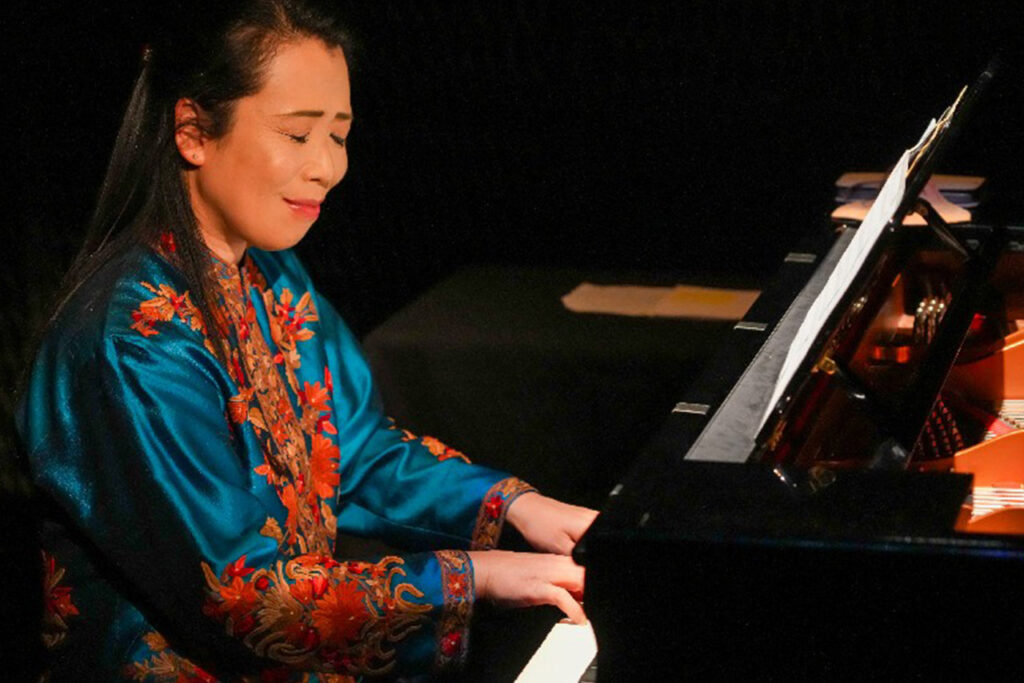New York Times by Brian Seibert
The five dance selections that are part of the Dance Reflections festival take varied approaches to piano exercises written by Philip Glass.
“Dancing With Glass: The Piano Etudes” is titled a little misleadingly. The five dance selections on the program, now at the Joyce Theater as part of the Dance Reflections festival, are all set to piano études by Philip Glass. But before and after each, the pianist Maki Namekawa plays another of the Glass keyboard exercises. Really, the show is Glass with dancing.
That is not a fault in itself, since Namekawa plays excellently. Besides filling out what would otherwise be a rather slight program, the extra musical selections give you a chance to rest your eyes and focus on listening. Or to watch the loving attention Namekawa gives to the technical challenge that each étude addresses, and to every little shift in Glass’s repetitions. The pleasure is visible.
The five distinct choreographers, or choreographic teams, face a different challenge, one of differentiation. The études — all recognizably Glassian in harmony, rhythm and oscillation — vary in character but are all a similar length, four to seven minutes. Simply by being a stylistically diverse bunch, the choreographers manage to make each selection distinct, yet Glass is so stylistically dominating that their different approaches, one after the other, end up underlining a sameness.
The Brazilian tap dancer Leonardo Sandoval, who comes first, is most successful in asserting himself. With four other dancers, he prefaces his take on the trainlike Etude No. 13 with his own claps and steps, until one of the dancers, Noé Kains, turns out, amusingly, to be a pianist, filling in for Namekawa.
Although the direct imitation of some of Glass’s rhythms gets a little clomping, the tapping and turning work well. At one point, Sandoval offers a Charleston-like kicking that can cause you to hear the music differently, a choreographic revelation. And his response to the étude’s typically unresolved ending is witty: He slips and falls and doesn’t get back up.
Lucinda Childs, whose piece comes last, represents an opposite pole of fidelity. Her version of Etude No. 18, a duet performed by Caitlin Scranton and Kyle Gerry, is a Platonic ideal of dancing to Glass. It might feel that way partly because Childs has been choreographing to his music for nearly 50 years. (“Dance,” her 1979 collaboration with the composer, opened the Dance Reflections festival in October.) But it’s also true that they are stylistic soul mates.
In silky pajamas, Scranton and Gerry spin side by side, or she around him. They hold hands courteously and stretch slightly away from each other, barely intimating an emotional connection. Childs honors Glass’s structure by repeating her own choreography, reversing its direction. Like Glass, she believes in repetition.
Between these poles, the other choreographers don’t fare as well. Justin Peck hears the one-note woodpeckering of Etude No. 6 as anxiety; a solo dancer in sneakers, doubled over on a stool, expands outward in an untangling of emotion and then collapses back. Patricia Delgado, whom I saw dance this on Thursday, is always lovely, but the concept is poor in imagination.
Bobbi Jene Smith and Or Schraiber, lithely crouching and rising through their own choreography, interpret Etude No. 8 as the dance of a troubled couple. Schraiber amazes with his mercurial flow, packing many colors into a burst of motion, but the concept, like Peck’s, is too commonplace. Similarly, Chanon Judson gorgeously stretches her long limbs through Etude No. 11 — shaking, shadowboxing, smiling, without revealing anything new in the music.
Sandoval does that, while Childs reminds us of the orthodox view. Tap dancers are often put first on a mixed bill, because of the special flooring they require, but this show might have been stronger in reverse order: starting with the standard and ending with the swerve.
Dancing with Glass: The Piano Etudes
Through Dec. 10 at the Joyce Theater; joyce.org.
Dec 1, 2023
https://www.nytimes.com/2023/12/01/arts/dance/review-dancing-with-glass-joyce-theatre.html
